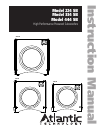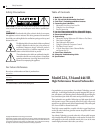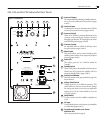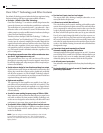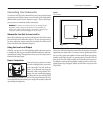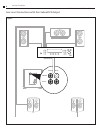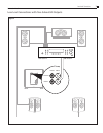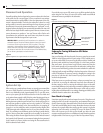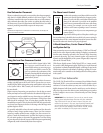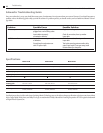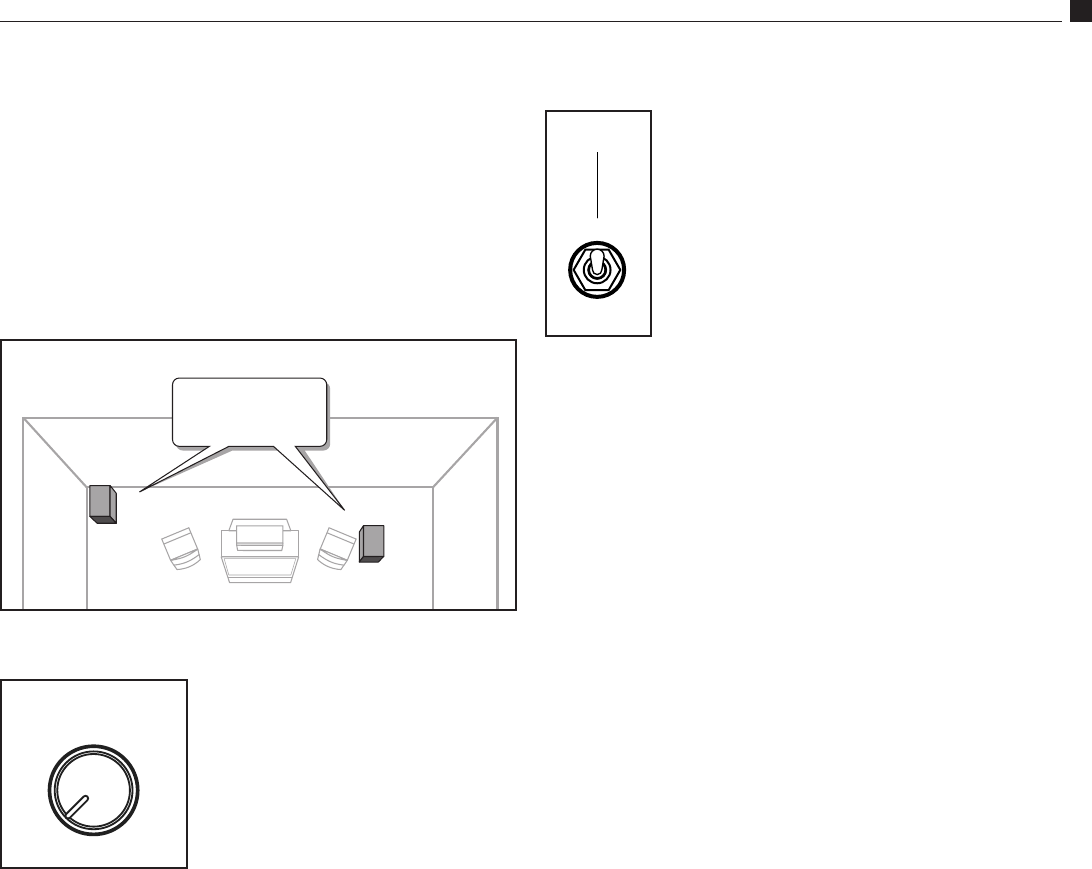
9
Instruction Manual
Care of your Subwoofer
Dual Subwoofer Placement
When two subwoofers are used, you may wish to place them asymmetri-
cally; that is, in slightly different positions in the room (Figure 7). This
will reduce common mode room resonances that occur with symmetri-
cally positioned subwoofers. You can also try placing the subwoofers in
the same corner, if you wish. Experiments have shown this to be a viable
means of producing smooth bass response in many rooms.
Figure 7
Asymmetrical arrangement for 2 subwoofers in a home theater, for example, one
closer to a corner than the other
The Phase Invert Control
A subwoofer operating out of phase with the rest of the
system won’t provide optimum low frequency perfor-
mance. To correct for this, a switch that will reverse the
phase of the subwoofer is provided on the amplifier
panel. Listen to a monaural musical source with strong
bass content. (For example, you can use the mono
switch on an FM tuner or preamp, or use a Y-connector
on the outputs of one of your source components to get
a mono signal.)
Experiment with the position of the phase switch to get
the smoothest bass. It should be obvious which is the correct setting. In
particular, there will be a more integrated transition between the satel-
lites and the subwoofer when they are properly phased.
A Word About Bass, Center Channel Modes
and System Set Up
Many surround processors and receivers feature a “Wide” and “Normal”
mode for the center channel speaker. Atlantic Technology recommends
that the center channel be operated in the “Normal” mode when using
a powered subwoofer. The center channel speaker will sound more
dynamic and the intelligibility of the system will generally be improved
when in the “Normal” mode.
With discrete digital systems (Dolby Digital, DTS, etc.) many control-
lers provide a Bass Management option, which lets you set the front and
rear speakers in a limited bandwidth (Small) or full range (Large) mode.
When using a subwoofer with Atlantic Technology speakers we recom-
mend setting such a controller to the Small position for all the speakers
in the system.
Care of Your Subwoofer
The 224 SB, 334 SB and 444 SB are constructed from Medium Density
Fiberboard. MDF is a non-resonant material ideal for speaker system
enclosures. To clean the cabinet you may use a soft cloth either dry or
slightly dampened with clean water. Be careful not to wet the cabinet or
allow any water to enter the cabinet seams. Avoid placing your speakers
in direct sunlight or near a source of heat that may, over time, damage
the finish.
IMPORTANT:
Save Your Boxes! If you can do so, save the carton,
packing pieces and plastic bags that came with your subwoofer.
They will be useful in case you move or have to ship your sub-
woofer for any reason. In any case, save all packing materials until
you are certain that the system has suffered no damage in ship-
ment. If you find such damage, either visible or internal, contact
your dealer immediately for the proper return procedure.
Place subwoofers
assymmetrically in room
for smoother bass
Using the Low-Pass Crossover Control
When used with the System 1400 or 2400,
the Crossover control should be set at
around 100Hz unless you are using a pro-
cessor with its own built-in crossover. The
goal is to optimize the performance of the
system by ensuring that the subwoofer and
satellites produce a cohesive and well inte-
grated sound “picture.”
Many surround sound receivers and processors offer a choice of crossover
settings, typically between 80 Hz and 120 Hz. If yours does, we recom-
mend using the 100Hz setting when using small speakers such as those
in the System 1400 or 2400. Consult your electronics owner's manual
for more details.
Higher crossover frequencies pass more bass to the sub but can sound
boomy and may be more easily localized to the subwoofer. Higher cross-
over frequencies may be suitable, however, when using very small satel-
lites that have no real low frequency performance. Settings lower than
80Hz should be employed if you are using larger speakers that have
extended bass response. This way, the subwoofer will only reproduce the
very lowest bass frequencies that are in the range where the large main
speakers begin to roll off.
It’s generally undesirable to have the main speakers and the subwoofer
overlap too much. Larger speakers means a lower Low-Pass crossover
frequency, smaller speakers means a higher Low-Pass crossover fre-
quency. Consult the manufacturer’s specified low frequency response
for your main speakers to determine the appropriate Low-Pass setting
on your subwoofer. In the end, however, a little time spent experimenting
will generally result in dramatically better bass response.
BYPASS
LOW-PASS
ON
AUTO
PHASE
NORMAL
INVERT
40
160
100
LOW-PASS
60
RIGHT
L/MONO
OUTPUT
INPUT
STATUS
ON OFF
AC INPUT
50-60Hz 300W MAX
220-240V110-120V
FOR 110-120VAC, USE 2.5AL 250V FUSE
FOR 220-240VAC, USE 1.25AL 250V FUSE
FOR CONTINUED PROTECTION AGAINST RISK OF FIRE,
REPLACE ONLY WITH SAME TYPE AND RATING OF FUSE
U.S. Patent #5,075,634 and
5,510,753 Patent Pending
AVIS: RISQUE DE CHOC ELECTRIQUE-NE PAS OUVRIR
RISK OF ELECTRIC SHOCK
DO NOT OPEN
CAUTION
WARNING: TO REDUCE THE RISK OF FIRE OR ELECTRIC SHOCK.
DO NOT EXPOSE THIS APPLIANCE TO RAIN OR MOISTURE.
DOUBLE INSULATION - WHEN SERVICING,
USE ONLY IDENTICAL REPLACEMENT PARTS
A
Z
A
R
D
S
S
S
E
COMPLIANT
E
S
R
H
I
O
T
R
I
C
T
N
O
F
O
U
C
B
S
T
A
N
U
BYPASS
LOW-PASS
ON
AUTO
PHASE
NORMAL
INVERT
40
160
100
LOW-PASS
60
RIGHT
L/MONO
OUTPUT
INPUT
STATUS
ON OFF
AC INPUT
50-60Hz 300W MAX
220-240V110-120V
FOR 110-120VAC, USE 2.5AL 250V FUSE
FOR 220-240VAC, USE 1.25AL 250V FUSE
FOR CONTINUED PROTECTION AGAINST RISK OF FIRE,
REPLACE ONLY WITH SAME TYPE AND RATING OF FUSE
U.S. Patent #5,075,634 and
5,510,753 Patent Pending
AVIS: RISQUE DE CHOC ELECTRIQUE-NE PAS OUVRIR
RISK OF ELECTRIC SHOCK
DO NOT OPEN
CAUTION
WARNING: TO REDUCE THE RISK OF FIRE OR ELECTRIC SHOCK.
DO NOT EXPOSE THIS APPLIANCE TO RAIN OR MOISTURE.
DOUBLE INSULATION - WHEN SERVICING,
USE ONLY IDENTICAL REPLACEMENT PARTS
A
Z
A
R
D
S
S
S
E
COMPLIANT
E
S
R
H
I
O
T
R
I
C
T
N
O
F
O
U
C
B
S
T
A
N
U



